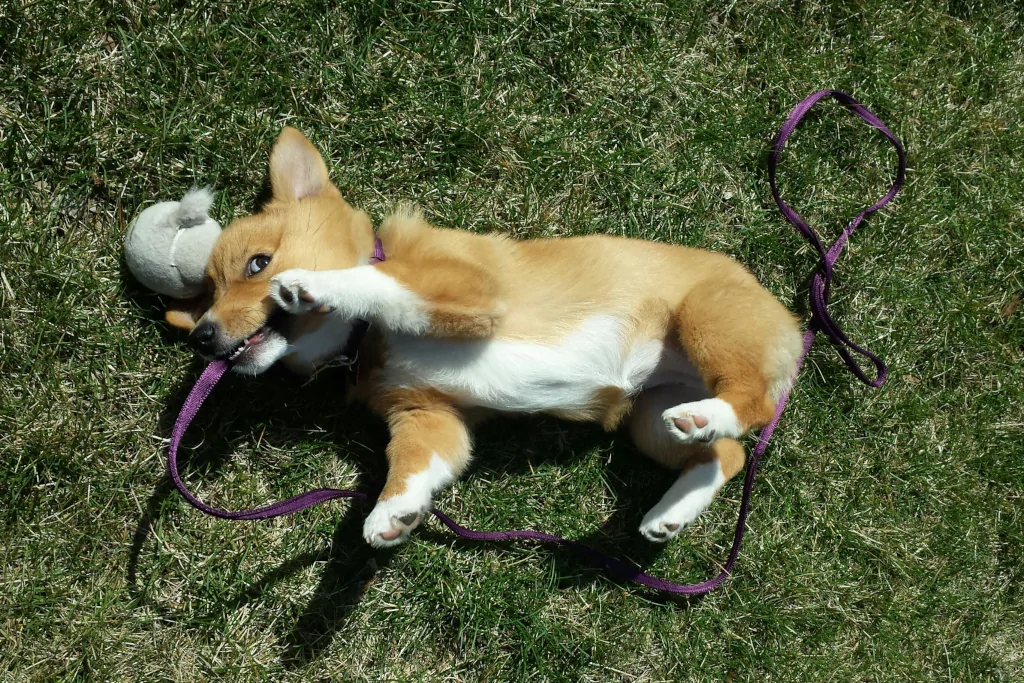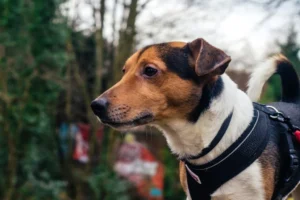Are you tired of being dragged around the block by your enthusiastic canine friend?
Imagine a walk in the park that’s smooth sailing, with you and your dog enjoying each other’s company without any strain.
Leash training is the key to unlocking this harmonious experience, and this guide has everything you need to embark on this journey with your four-legged buddy.
Get ready to explore the world of leash training, where we’ll unravel the benefits, techniques, and tips to make your strolls a walk in the park – literally and figuratively!
For loose leash walking, follow this guide.

Why is Leash Training Essential?
Leash training is more than just a matter of obedience – it’s about safety and communication.
Untrained dogs can put themselves and others at risk, whether it’s darting into traffic, approaching an aggressive dog, or causing accidents.
Moreover, dogs that constantly pull can strain their neck muscles or even suffer from tracheal damage, especially if they’re using a collar.
By mastering leash training, you’ll establish a mutual understanding with your canine companion, ensuring a controlled and enjoyable experience for both of you on your walks.
Benefits of Proper Leash Training
Apart from safety, proper leash training offers a plethora of benefits.
It strengthens the bond between you and your dog by fostering trust and respect. Well-trained dogs also enjoy more freedom, as they can be taken to a variety of places without causing trouble.
Furthermore, dogs that walk well on a leash tend to get more physical exercise since owners are more likely to take them out more frequently without the hassle of being dragged.
Lastly, this skill reduces stress during vet visits or encounters with other animals, making life more pleasant for you, your dog, and everyone around you.
Creating a Positive Leash Training Experience
Embarking on the leash training journey should be a positive and enjoyable experience for both you and your dog. By following these steps, you’ll be able to create a strong foundation for a well-behaved canine companion:
- Choose the right equipment. Select a comfortable and well-fitting collar or harness for your dog. A flat collar is often suitable for most dogs, but a harness may be a better option for dogs that pull excessively or have breathing difficulties.
- Begin indoors. Introduce your dog to the leash and collar or harness in a familiar environment. Put it on and let your dog explore the house while wearing it, giving them time to adjust before moving outdoors.
- Use treats and praise. Arm yourself with your dog’s favorite treats and lots of positive reinforcement. Reward your dog immediately for staying close to you and maintaining a loose leash during training sessions. Be consistent with the rewards, offering treats or praise every time they exhibit the correct behavior.
- Start with short sessions. Start with sessions as short as 5 minutes for the first few days. Then, gradually increase the duration by 2-3 minutes every couple of days each time until you reach a comfortable duration of 15-20 minutes. This helps to prevent your dog from becoming overwhelmed or frustrated.
- Keep a consistent pace. Maintain a steady walking speed, encouraging your dog to match your pace. If your dog starts to pull, stop walking, and only resume once the leash becomes loose again.
- Introduce distractions. Begin with simple training in a low-distraction environment, like your backyard or a quiet room. As your dog becomes more comfortable with the leash, introduce more distractions, like other people or dogs, and practice in busier environments, such as parks or streets.
- Use verbal cues. Teach your dog basic commands like “heel” to encourage them to stay by your side. Be consistent with your commands and reward your dog for following them correctly.
- Be patient and persistent. Leash training may take time, so be prepared for setbacks and progress at your dog’s pace. Consistency, patience, and positive reinforcement will go a long way in creating a successful and enjoyable leash training experience.
By following these steps and incorporating them into your daily routine, you’ll lay the foundation for a positive and effective leash training experience, ensuring your walks become more enjoyable for both you and your dog.
In addition, here’s a complete, easy-to-follow guide on picking a training leash.

Using Positive Reinforcement in Leash Training
Positive reinforcement is the cornerstone of successful leash training.
It revolves around rewarding your dog for displaying desirable behaviors, which encourages them to repeat those actions.
Treats, praise, and toys are all effective ways to reinforce good behavior during leash training. Make sure to choose high-value rewards that your dog genuinely loves, as this will help to maintain their focus and motivation.
Read more: How to Pick Perfect Training Toys for Your Dog
Timing is crucial when using positive reinforcement – always reward your dog immediately after they perform the desired action. This ensures that they associate the reward with the specific behavior, making it more likely they’ll repeat it in the future.
Overcoming Common Leash Training Challenges
Even with the best intentions and methods, leash training can come with its fair share of challenges. Here are some common issues you might encounter and practical solutions to help you overcome them:
Pulling on the leash.
If your dog constantly pulls, stop walking and wait for them to return to your side and loosen the leash before resuming. Consistently reinforce this behavior to help your dog understand that pulling will not get them where they want to go.
Fear or anxiety.
Some dogs may be fearful of the leash or the outdoors. Start by creating positive associations with the leash indoors and gradually build up their confidence by exposing them to new environments, starting with quiet, low-distraction areas.
Refusing to walk.
If your dog refuses to walk, try using treats or toys to lure them forward. Be patient and reward even small steps in the right direction.
Leash biting.
If your dog starts biting or playing with the leash, redirect their attention with a toy or treat. Consistently reinforcing this redirection can help break the habit.
By addressing these common challenges head-on and maintaining a consistent, positive approach, you’ll be well on your way to a successful leash training experience with your faithful sidekick.
Recommended: Training Aids for Leash Pulling
Tips for Building a Strong Leash Training Foundation
Building a strong leash training foundation is crucial to ensure a smooth, enjoyable experience for both you and your dog. Here are some tips to help you establish a solid groundwork:
- Consistency is key. Stick to a regular training schedule and be consistent with your commands, rewards, and expectations. This helps your dog understand what’s expected of them and makes the training process more effective.
- Adjust to your dog’s needs. Every dog is unique, so be prepared to adapt your training methods based on your dog’s temperament, breed, and individual characteristics. This may involve adjusting the pace of training, the type of rewards used, or the level of difficulty.
- Socialize your dog. Expose your dog to various environments, people, and other animals, as this will help them become more confident and well-adjusted, making leash training more manageable.
- Keep training sessions fun and engaging. Mix in playtime and affection with the training process, as this will help your dog associate leash training with positive experiences and strengthen your bond.
- Manage expectations. Remember that progress may be slow, especially with older dogs or those with previous negative experiences. Celebrate small successes and be patient as you build a strong foundation for leash training.
By following these tips and staying consistent in your efforts, you’ll create a lasting bond with your dog and make leash training a positive, rewarding experience for both of you.
Here’s a great video on how to get started with leash training:
FAQs
What type of leash is best for leash training?
A flat, sturdy, and comfortable nylon or leather leash, about 4-6 feet in length, is ideal for leash training.
How do I choose the right collar or harness for leash training?
Choose a collar or harness that fits your dog snugly but comfortably, opting for a flat collar for most dogs or a harness for dogs that pull excessively or have breathing difficulties.
What should I do if my dog starts biting or playing with the leash?
If your dog starts biting or playing with the leash, redirect their attention with a toy or treat, and consistently reinforce this redirection to break the habit.
Alex, a passionate animal lover, has experience in training and understanding animal behavior. As a proud pet parent to two dogs and three cats, he founded AnimalReport.net to share insights from animal experts and expand his knowledge of the animal kingdom.




